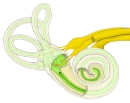
・「Both the oval and round windows are about the same size, approximately 2.5 mm2.」(Wikipedia)

|
 |
 |
|
骨・膜迷路 |
骨・膜迷路 |
骨迷路 |
蝸牛ラセン管(模型図) |
以下は「Wikipedia」の解説文となる。
The round window is one of the two openings from the middle ear into the inner ear. It is sealed by the secondary tympanic membrane (round window membrane), which vibrates with opposite phase to vibrations entering the inner ear through the oval window. It allows fluid in the cochlea to move, which in turn ensures that of the basilar membrane will be stimulated and that audition will occur.
【 語 句 】
・middle ear:中耳 ・inner ear:内耳 ・secondary tympanic membrane:第2鼓膜 ・oval window:卵円窓 ・cochlea:蝸牛 ・basilar membrane:基底板 ・audition:聴力、聴覚
【Structure】
The round window is situated below and a little behind the oval window, from which it is separated by a rounded elevation, the promontory.
It is placed at the bottom of a funnel-shaped depression (the round window niche) and, in the macerated bone, opens into the cochlea of the internal ear; in the fresh state it is closed by a membrane, the secondary tympanic membrane (Latin: membrana tympani secundaria, or membrana fenestra cochleae)) or round window membrane, which is a complex saddle point shape. The visible central portion is concave (curved inwards) toward the tympanic cavity and convex (curved outwards) toward the cochlea; but towards the edges, where it is hidden in the round window niche, it curves the other way.
This membrane consists of three layers:
- an external, or mucous, derived from the mucous lining of the tympanic cavity;
- an internal, from the lining membrane of the cochlea;
- and an intermediate, or fibrous layer.
The membrane vibrates with opposite phase to vibrations entering the cochlea through the oval window as the fluid in the cochlea is displaced when pressed by the stapes at the oval window. This ensures that hair cells of the basilar membrane will be stimulated and that audition will occur.
Both the oval and round windows are about the same size, approximately 2.5 mm2. The entrance to the round window niche is often much smaller than this.
【 語 句 】
・promontory:岬角 ・funnel:漏斗 ・niche:適所? ・macerated:柔らかくなった? ・in the fresh state:生体では ・saddle point:鞍状点 ・concave:凹状の ・tympanic cavity:鼓室 ・convex:凸状の ・mucous:粘液を分泌する ・stapes:アブミ骨
【Function】
The stapes bone transmits movement to the oval window. As the stapes footplate moves into the oval window, the round window membrane moves out, and this allows movement of the fluid within the cochlea, leading to movement of the cochlear inner hair cells and thus hearing. If the round window were to be absent or rigidly fixed (as can happen in some congenital abnormalities), the stapes footplate would be pushing incompressible fluid against the unyielding walls of the cochlea. It would therefore not move to any useful degree leading to a hearing loss of about 60dB. This is, unsurprisingly, the same as for conditions where the stapes itself is fixed, such as otosclerosis.
【 語 句 】
・inner hair cells:内有毛細胞 ・rigidly:堅く ・congenital abnormality:先天性異常 ・incompressible:圧縮できない ・unyielding:堅い ・unyielding:耳硬化症 ・otosclerosis:耳硬化症
■ 写真やイラストを掲載しているサイト ■
・ イラストや写真を掲載しているサイト-Ⅰ
・ イラストや写真を掲載しているサイト-Ⅱ
・ イラストや写真を掲載しているサイト-Ⅲ
・ イラストや写真を掲載しているサイト-Ⅳ
